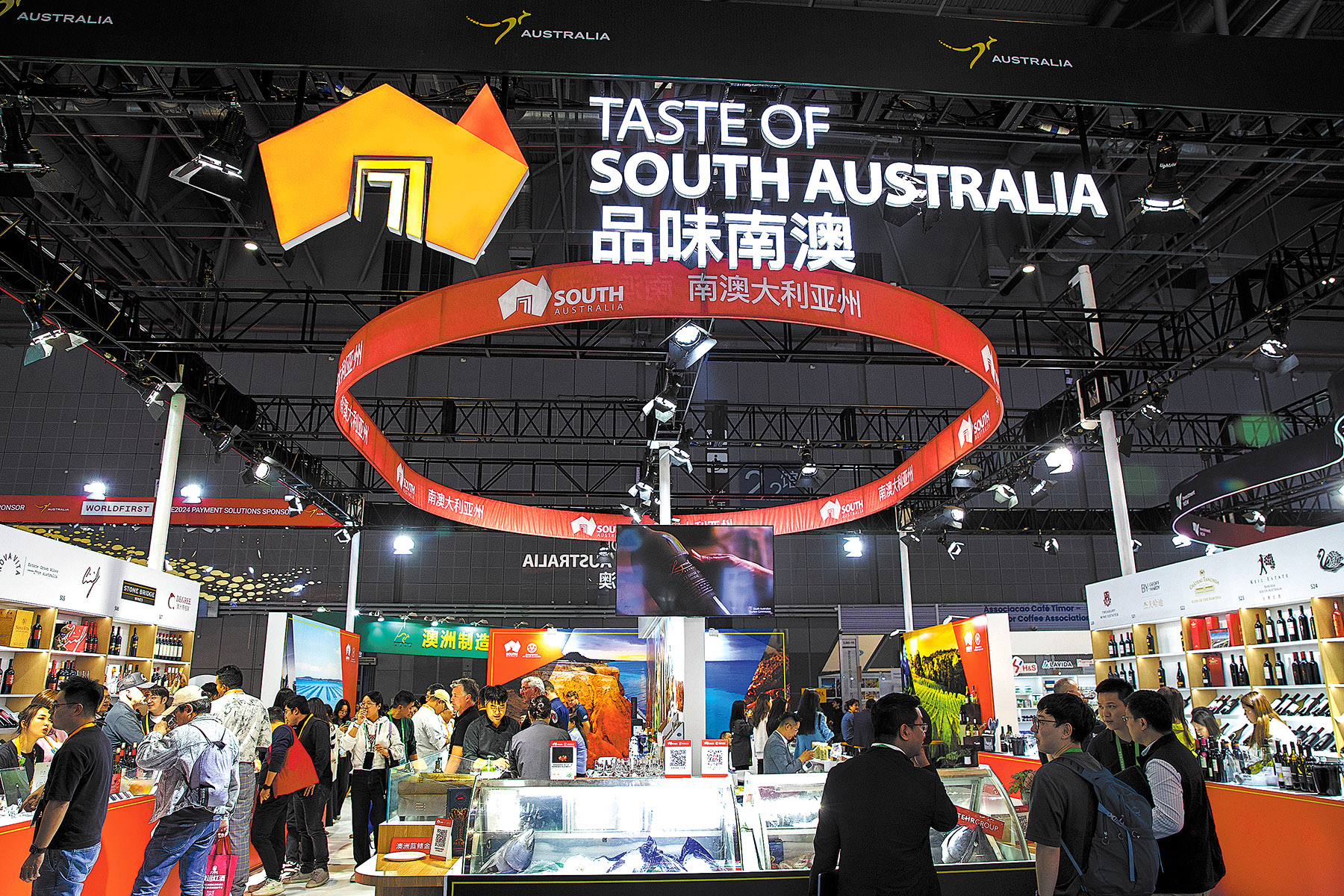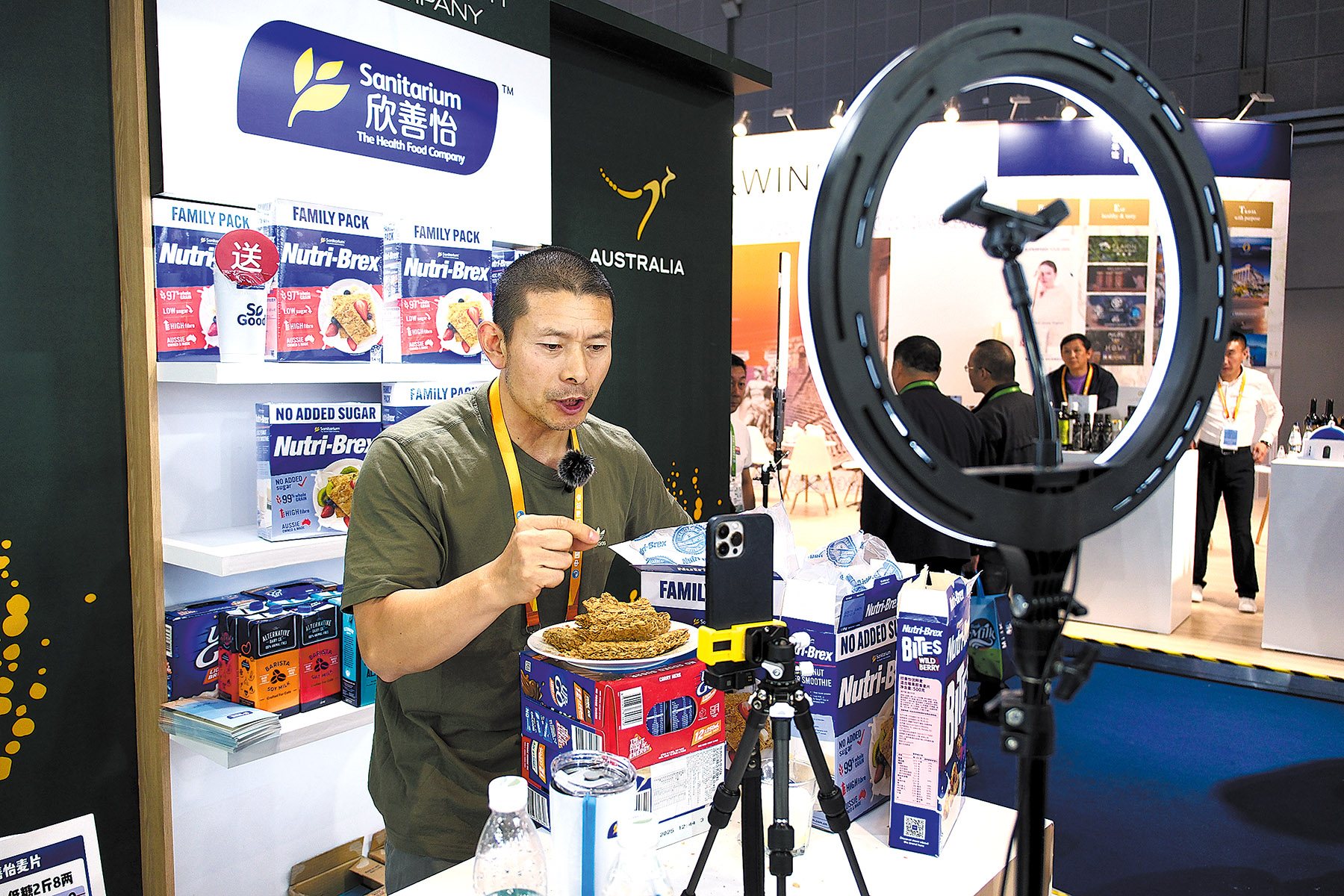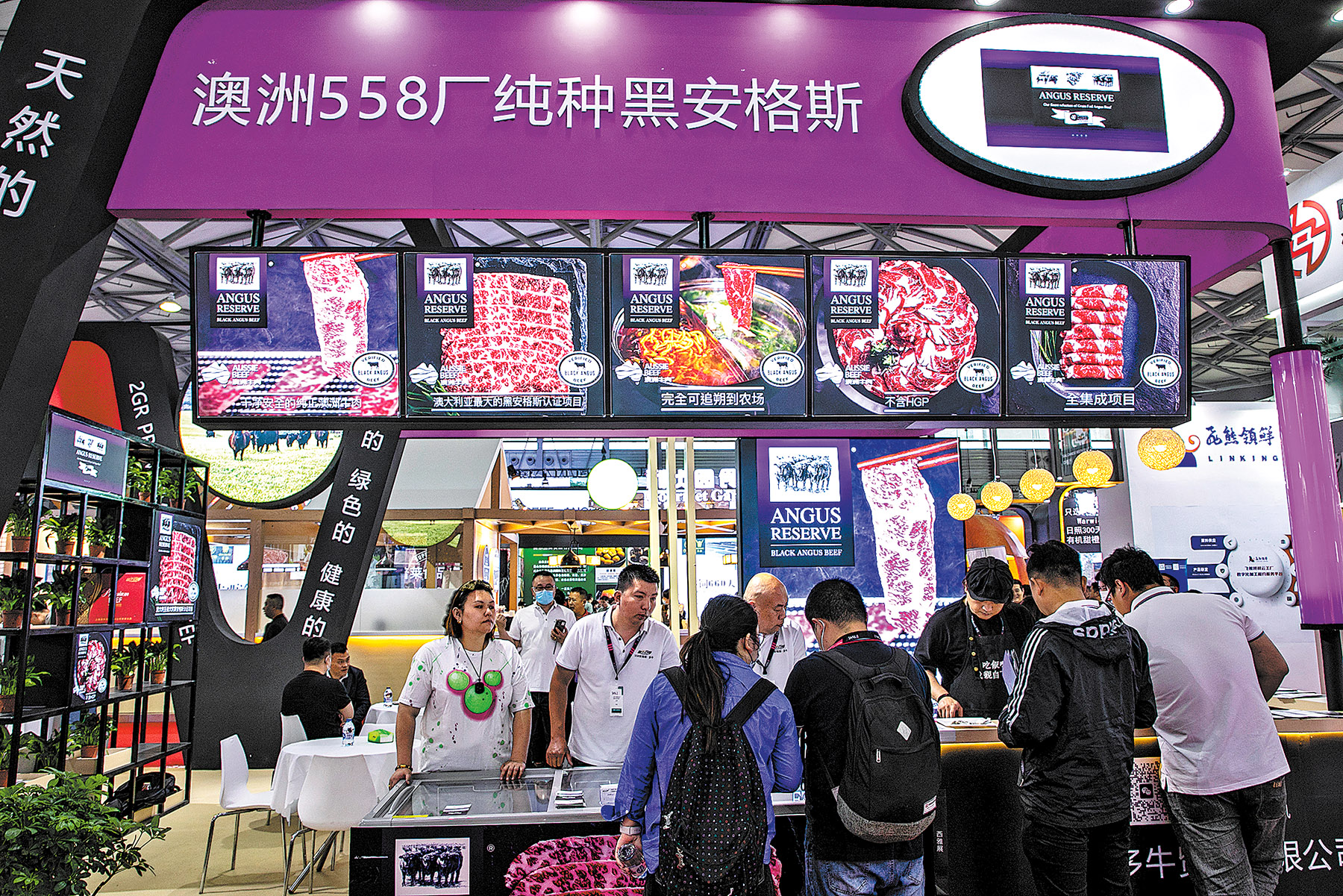Analysts hail first 10 years of China-Australia free trade deal, share optimism for future amid global challenges

Australia's landmark free trade agreement with China has reaped significant rewards in the decade since it was signed, proving wrong initial skepticism and becoming a bright spot amid challenges to the global economy, analysts and stakeholders said.
"There were lots of different people who had a passion, who had a vision, and they wanted to make it happen," said Andrew Robb, who, as Australia's trade and investment minister, signed the agreement with then-Chinese commerce minister Gao Hucheng in Canberra in June 2015.
"They saw the benefit of two countries coming together in a more meaningful and powerful way, and we ended up with it all happening," Robb said in a speech at an industry event in Sydney in late May to mark the 10th anniversary of the China-Australia Free Trade Agreement, or ChAFTA.
READ MORE: Aussie trade minister: FTA boosts prosperity in Australia, China
The agreement and its results confirm that free trade works for the benefit of all, but there are still threats of de-globalization and protectionism coming from other parts of the world today, Robb said.
Australia's trade with China since ChAFTA has grown from A$144.8 billion ($93.4 billion) to A$325.5 billion, a 124.8 percent increase, compared with 76.5 percent growth with the rest of the world, according to an April report by the Australia-China Relations Institute at the University of Technology Sydney, that assessed the free trade agreement a decade on.
The Chinese market "has outperformed the rest of the world across both exports and imports and almost all broad categories of goods and services", the report added.
"The overall assessment is that ChAFTA has been overwhelmingly in Australia's national interest," James Laurenceson, director of the institute and author of the report, told China Daily.

Labor positives
The free trade agreement has not negatively impacted the Australian labor market, as initially thought by its critics.
"In 2014 and 2015, when the Australian public was debating whether the China-Australia Free Trade Agreement was a good idea or not, there were two camps," Laurenceson said.
"There were the advocates who pointed to the fact that ChAFTA would create trade and boost Australian prosperity. There were also people on the other side, the critics who argued that it would change the Australian labor market in fundamental ways," he said.
"They imagined thousands and thousands of Chinese workers coming to Australia and displacing local jobs," Laurenceson said, noting there are actually fewer temporary Chinese workers in Australia today than there were in 2015.
The report said temporary labor migration from China has fallen, both in absolute numbers and as a proportion of the total, and there is "no compelling evidence presented that links unsafe workplace practices in Australia to ChAFTA's provisions".
According to the report, that, and other major outcomes, "help to explain why a decade on, Australian public support for ChAFTA remains strong".
The benefits of trade remain clear in Australia-China bilateral ties of the past decade, Laurenceson said, noting that this can offer the rest of the world a lesson amid challenges to globalization, such as the recent worldwide tariffs imposed by the United States.
Businesses that continue to engage with each other can help the broader bilateral relationship and provide it with ballast amid any political differences or difficulties, he said. "It's useful to remember that those connections between businesses and between people do bring benefits for the broader relationship, and certainly ChAFTA has played a role in boosting those connections," Laurenceson said.
"It raised awareness among Australian and Chinese businesses and households of the economic complementarities between our two countries, and it made it easier for households and firms to capitalize on those opportunities because barriers to trade were reduced by both sides."
Laurenceson said that the economic and trade ties between the two countries remain bright, with growth areas beyond traditional sectors like minerals holding significant potential.
"I remain convinced that the best days of the Australia-China economic relationship are in the future," he said.
"Of course, over time, some goods will diminish in importance. We know now, for example, more of China's growth these days is driven by high-tech industries, less by investment in infrastructure, residential construction," he said. "So, of course, China won't need as much steel in the future, which means it will need less iron ore … that's just a gradual decline, and frankly, it's what everyone should be expecting.
"Our own minerals companies have been expecting that for decades, so I don't really think that's troubling," he noted.
"China's own productive capabilities are becoming more and more complete and complex … five years ago, China was not a major exporter of electric vehicles, now they are the world's clear leader," Laurenceson said.
Zhou Mi, a researcher at the Chinese Academy of International Trade and Economic Cooperation, said: "A better-developed China-Australia economic and trade ties can not only support Australian businesses to sustain their growth amid rising geopolitical tensions, the disruption of both global and regional supply chains, and unilateral moves, but also benefit Chinese consumers through increased product availability and lower prices."
The two nations' complementary trade structures and mutual investment help them diversify their economies and take advantage of each other's strengths, Zhou said.

Aiding green transition
Australia's commitment to facilitating trade with China under ChAFTA has helped fuel the increasingly important position of Chinese EVs in Australia's major green transition.
According to the Electric Vehicle Council, the peak national body representing the country's EV industry, EVs accounted for more than 14 percent of all new cars sold in Australia in March, the highest monthly share on record. Over 15,300 battery EVs and plug-in hybrid EVs were sold.
"Australians are enjoying cheaper-to-run, greener cars from across the world, including China. The Chinese EV industry is providing Australians with options across models that cater to different lifestyles," said Aman Gaur, head of legal affairs, policy, and advocacy at the Electric Vehicle Council.
"Free trade under ChAFTA has helped Australians access Chinese EVs. In addition, the Australian government's removal of tariffs from imported electric cars in 2022 has also contributed to more choice at lower prices in Australia's car industry," he told China Daily.
"Australia's transport emissions make up about one-fifth of our national emissions. With electric vehicles, Australians are able to decarbonize and move to a greener future with electric cars from across the world," Gaur said.
Ma Lei, president of the Council of Foreign Relations, a chapter of the China Chamber of Commerce in Australia, said ChAFTA "has not only transformed bilateral trade but also deepened our economic integration, fostering mutual prosperity and resilience in an ever-changing global landscape".
"As the world's second-largest economy and a leading manufacturer, China remains steadfast in its commitment to comprehensive reforms, modernization and high-quality development," said Ma, whose organization represents over 450 Chinese enterprises operating across Australia.
"Its green economy transition opens unprecedented opportunities for collaboration with Australia, particularly in advancing sustainability, fostering innovation, and working toward a net-zero future," he said.
Steven Ducat, CEO and founder of SPD Energy, an Australian-owned Chinese enterprise, said the agreement is a "catalyst, a recognition of the growing interdependence between our economies" for businesses like his operating on the ground.
Ducat's company has a flagship manufacturing facility located in Foshan, Guangdong province, and he has been living and working in China for 25 years.
"It supercharged the partnerships we were already building, providing clarity and confidence," he said. "For SPD Energy, ChAFTA created the framework that allowed us to truly combine Australian innovation with China's incredible manufacturing capabilities, accelerating the delivery of green energy solutions across the whole region," Ducat added.

Vital conduit
Ducat believes that beyond traditional trade, there is genuine potential for co-creation and shared opportunities for Australian companies.
"Australia brings our unique design ingenuity, deep understanding of building for harsh environments, our rich mineral resources, and policy support," he said.
"China brings its world-leading battery innovation, unparalleled manufacturing scale, and established pathways into these vast global markets, many within the Belt and Road Initiative. This is how we find powerful mutual benefit.
"A modernized ChAFTA becomes the vital conduit, ensuring our joint ventures have privileged access, allowing us to truly access global markets together," Ducat noted.
Australia's Department of Foreign Affairs and Trade said: "ChAFTA is delivering enormous benefits to Australia, enhancing our competitive position in the Chinese market, boosting economic growth, and creating jobs".
DFAT also said China is Australia's largest trading partner, noting that trade and investment with China are central to the country's future prosperity.
In the agricultural sector, China is Australia's largest export market, worth an estimated A$17.2 billion ($11.12 billion) in 2023, according to the DFAT, with Chinese demand for agricultural products forecast to more than double by 2050.
According to a fact sheet released by the department, ChAFTA has reduced tariffs on multiple Australian agricultural and processed food exports, including beef, dairy, seafood and other goods. This has given Australian exporters significant competitive advantages over their international rivals.
"In the past, the absence of a bilateral FTA with China meant Australian producers and exporters faced significant tariffs on agricultural products, and were at a competitive disadvantage to countries that had an FTA with China — including New Zealand, Chile and ASEAN(Association of Southeast Asian Nations)," said DFAT.
"ChAFTA addresses this issue, and also gives Australia a significant advantage over other larger players, such as the US, EU and Canada," it added.
Seafood success story
The success of premium seafood supplier Ferguson Australia, based in South Australia state, reflects the shared benefits under ChAFTA.
"The Chinese market remains critically important for Australian seafood exports, particularly for southern rock lobster, which is wild-caught in South Australia," Andrew Ferguson, the company's managing director, told China Daily.
"Free trade with China creates significant opportunities for both developing and refining new market segments within this vast and dynamic marketplace," Ferguson said.
"It also enables the identification and establishment of partnerships with top-tier supply chain providers who can deliver full transparency and direct routes to the end customer," said Ferguson.
In April, his company signed a memorandum of understanding with China Eastern Airlines — a major Chinese airline and cold chain logistics company — to further explore the Chinese market.
In the year to February, seafood exports to China grew by almost 500 percent to A$63.3 million, said South Australian authorities. This was led by A$47.1 million in southern rock lobster exports, with over 520 metric tons exported in just two months since trade barriers were removed.
Australia's horticultural sector is set to reap more rewards from the growing bilateral trade under ChAFTA.
Many Australian products enjoy quarantine access protocols for export into China amid the progressive elimination of tariffs, said DFAT.
In late April, Australian apple producers welcomed a move to sell more fruit to Chinese consumers.
Apple and Pear Australia Ltd said that a new protocol signed to allow apples grown on the Australian mainland to be exported to China "marks a significant step forward for Australian growers looking to expand into viable international markets".
"Following several years of positive dialogue and engagement, exports of Australian mainland apples to China are set to commence in the 2026 season," said APAL, which positions itself as the national representative for Australia's A$600 million apple and pear industry.
ALSO READ: Trade minister: Re-elected Australian govt wants to do more business with China
Previously, apples grown in Australia's southern island state of Tasmania could be exported, but not those from the Australian mainland because of fruit fly concerns.
Jeremy Griffith, APAL's head of industry and government relations and advocacy, told China Daily that the move marked "a great opportunity (for) accessing the premium market in the Asian region" amid the trade developments under ChAFTA.
"In Australia, we're very reliant upon domestic retailers … so here's an opportunity for us to grow highquality apples and to be able to export them to an overseas market," he said.
In assessing the first decade of ChAFTA, Australia's former trade minister Robb said mechanisms can now be used to review the agreement for more opportunities and build on its achievements for the next decade and beyond.
"It's true now that we've had 10 years of experience. We've had some rocky times. We got through it all and still held up," he said. "It's an architecture. It's an agreement that is sustainable, and we've got to keep using it."
Zhong Nan contributed to this story.
Contact the writers at xinxin@chinadaily.com.cn


